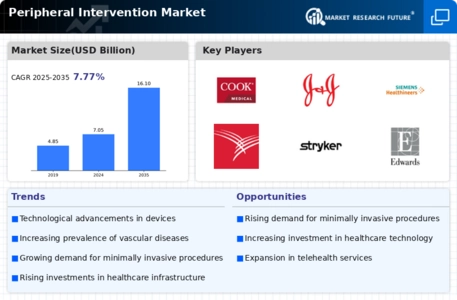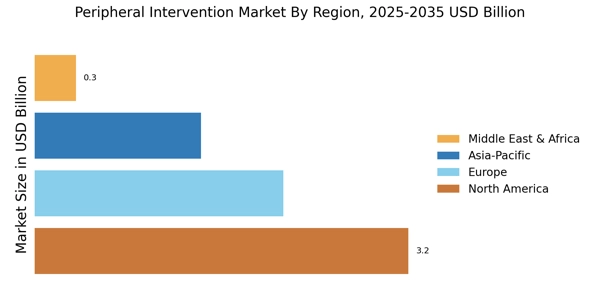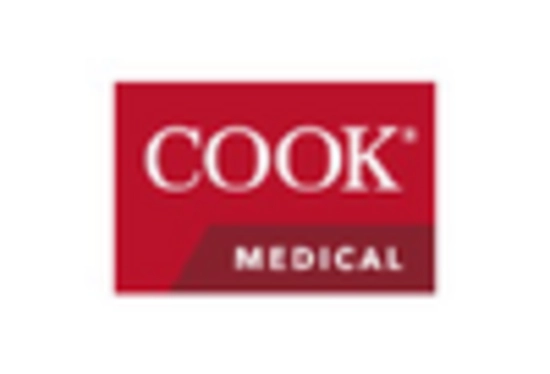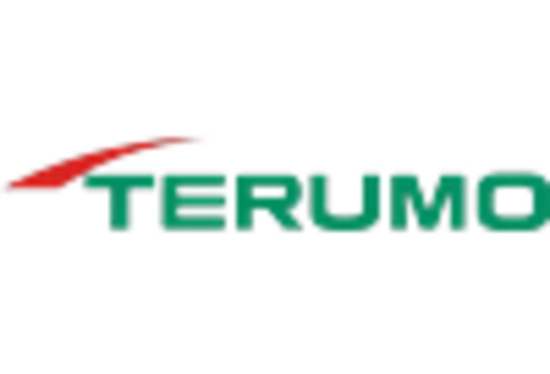Focus on Personalized Medicine
The trend towards personalized medicine is significantly influencing the Peripheral Intervention Market. Tailoring treatment plans to individual patient needs enhances the efficacy of interventions and improves overall outcomes. This approach is particularly relevant in the context of vascular diseases, where patient-specific factors such as genetics, lifestyle, and comorbidities play a crucial role in treatment success. The market is witnessing an increase in the development of customized devices and therapies that cater to these unique patient profiles. As healthcare systems increasingly adopt personalized strategies, the Peripheral Intervention Market is likely to see a surge in demand for innovative solutions that align with this trend. This shift not only enhances patient care but also drives market growth as stakeholders invest in research and development to create more effective, individualized treatment options.
Government Initiatives and Funding
Government initiatives and funding are pivotal in shaping the Peripheral Intervention Market. Various health authorities are recognizing the importance of addressing vascular diseases and are allocating resources to improve treatment accessibility and outcomes. For instance, funding for research and development of new peripheral intervention technologies is on the rise, with several countries implementing programs aimed at enhancing healthcare infrastructure. These initiatives are likely to stimulate innovation within the market, encouraging companies to develop advanced devices and therapies. Additionally, public health campaigns aimed at raising awareness about vascular health are expected to increase patient engagement and demand for interventions. As a result, the Peripheral Intervention Market stands to benefit from these supportive governmental actions, which may lead to a more robust and dynamic market landscape.
Aging Population and Lifestyle Changes
The aging population, coupled with lifestyle changes, is a significant driver of the Peripheral Intervention Market. As individuals age, the risk of developing vascular diseases escalates, necessitating effective intervention strategies. Moreover, lifestyle factors such as sedentary behavior, poor diet, and increased prevalence of diabetes are contributing to the rise in vascular conditions. Data indicates that by 2030, the number of individuals aged 65 and older is expected to reach 1.5 billion, creating a substantial demand for peripheral interventions. This demographic shift is prompting healthcare providers to focus on preventive measures and advanced treatment options. Consequently, the Peripheral Intervention Market is likely to expand as it adapts to the needs of an aging population, emphasizing the importance of innovative solutions to address the challenges posed by these lifestyle changes.
Rising Prevalence of Vascular Diseases
The increasing incidence of vascular diseases is a critical driver for the Peripheral Intervention Market. Conditions such as peripheral artery disease (PAD) and chronic venous insufficiency are becoming more prevalent, particularly among aging populations. Data suggests that approximately 8 to 12 million individuals in the United States alone are affected by PAD, highlighting a substantial patient base requiring intervention. This rising prevalence is prompting healthcare providers to seek advanced treatment options, thereby fueling demand for peripheral intervention devices. As awareness of vascular health continues to grow, the market is likely to expand, with an emphasis on innovative solutions that address these conditions effectively. The Peripheral Intervention Market is thus positioned to benefit from this demographic shift, as more patients seek timely and effective interventions.
Technological Advancements in Peripheral Intervention
The Peripheral Intervention Market is experiencing a notable transformation due to rapid technological advancements. Innovations such as minimally invasive techniques, advanced imaging modalities, and the development of bioresorbable stents are enhancing procedural outcomes. For instance, the introduction of robotic-assisted devices is streamlining complex interventions, thereby reducing recovery times and improving patient satisfaction. According to recent data, the market for peripheral vascular devices is projected to reach USD 8 billion by 2026, driven by these technological innovations. Furthermore, the integration of artificial intelligence in imaging and diagnostics is likely to enhance the precision of interventions, making them safer and more effective. This trend indicates a shift towards more sophisticated and efficient treatment options within the Peripheral Intervention Market.


















Leave a Comment